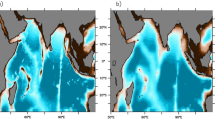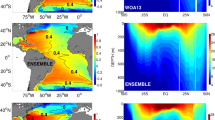Abstract
The South Florida Hybrid Coordinate Ocean Model (SoFLA-HYCOM) encompasses a variety of coastal regions (the broad Southwest Florida shelf, the narrow Atlantic Keys shelf, the shallow Florida Bay, and Biscayne Bay) and deep regions (the Straits of Florida), including Marine Protected Areas (the Florida Keys Marine Sanctuary and the Dry Tortugas Ecological Reserve). The presence of the strong Loop Current/Florida Current system and associated eddies connects the local and basin-wide dynamics. A multi-nested approach has been developed to ensure resolution of coastal-scale processes and proper interaction with the large scale flows. The simulations are free running and effects of data assimilation are introduced through boundary conditions derived from Global Ocean Data Assimilation Experiment products. The study evaluates the effects of boundary conditions on the successful hindcasting of circulation patterns by a nested model, applied on a dynamically and topographically complex shelf area. Independent (not assimilated) observations are employed for a quantitative validation of the numerical results. The discussion of the prevailing dynamics that are revealed in both modeled and observed patterns suggests the importance of topography resolution and local forcing on the inner shelf to middle shelf areas, while large scale processes are found to dominate the outer shelf flows. The results indicate that the successful hindcasting of circulation patterns in a coastal area that is characterized by complex topography and proximity to a large scale current system requires a dynamical downscaling approach, with simulations that are nested in a hierarchy of data assimilative outer models.














Similar content being viewed by others
References
Beardsley RC, Butman B (1974) Circulation on the New England continental shelf: response to strong winter storms. Geophys Res Lett 1:181–184
Bleck R (2002) An oceanic general circulation model framed in hybrid isopycnic–cartesian coordinates. Ocean Modelling 4:55–88
Browning GL, Kreiss H-O (1982) Initialization of the shallow water equations with open boundaries by the bounded derivative method. Tellus 34:334–351
Browning GL, Kreiss H-O (1986) Scaling and computation of smooth atmospheric motions. Tellus 38A:295–313
Canuto VM, Howard A, Cheng Y, Dubovikov MS (2001) Ocean turbulence, Part I: one-point closure model. Momentum and heat vertical diffusivities. J Phys Oceanogr 31:1413–1426
Canuto VM, Howard A, Cheng Y, Dubovikov MS (2002) Ocean turbulence, Part II: vertical diffusivities of momentum, heat, salt, mass, and passive scalars. J Phys Oceanogr 32:240–264
Chassignet EP, Smith LT, Halliwell GR, Bleck R (2003) North Atlantic simulations with the HYbrid Coordinate Ocean Model (HYCOM): impact of the vertical coordinate choice, reference density, and thermobaricity. J Phys Oceanogr 33:2504–2526
Chassignet EP, Hurlburt HE, Smedstad OM, Halliwell GH, Hogan PJ, Wallcraft AJ, Baraille R, Bleck R (2007) The HYCOM (Hybrid Coordinate Ocean Model) data assimilative system. J Mar Sys 65:60–83
Cooper M, Haines K (1996) Atlimetric assimilation with water property conservation. J Geophys Res 101:1059–1078
Csanady GT (1978) The arrested topographic wave. J Phys Oceanogr 8:47–62
Cummings JA (2005) Operational multivariate ocean data assimilation. J R Meteorol Soc 131:3583–3604
Daley R (1991) Atmospheric data analysis. Cambridge University Press, Cambridge, p 457
Fox DN, Teague WJ, Barron CN, Carnes MR, Lee CM (2002) The Modular Ocean Data Analysis System (MODAS). J Atmos Ocean Technol 19:240–252
Halliwell GR Jr (2004) Evaluation of vertical coordinate and vertical mixing algorithms in the HYbrid-Coordinate Ocean Model (HYCOM). Ocean Model 7:285–322
Halliwell GR Jr, Weisberg RH, Mayer DA (2003) A synthetic float analysis of upper-limb meridional overturning circulation interior ocean pathways in the tropical/subtropical Atlantic. In: Goni G, Malanotte-Rizzoli P (eds) Interhemispheric water exchange in the Atlantic Ocean. Elsevier, Amsterdam, pp 93–136
Halliwell GR Jr, Barth A, Weisberg RH, Hogan PB, Smedstad OM, Cummings J (2008) Impact of GODAE products on nested HYCOM simulations on the West Florida Shelf. Ocean Dynamics (this issue)
Hamilton P, Larsen JC, Leaman KD, Lee TN, Waddell E (2005) Transports through the Straits of Florida. J Phys Oceanogr 35:308–322
Hetland RD, Hsueh Y, Leben R, Niiler PP (1999) A Loop Current-induced jet along the edge of the west Florida shelf. Geophys Res Lett 26:2239–2242
Hodur RM (1997) The Navy Research Laboratory’s Coupled Ocean/Atmosphere Mesoscale Prediction System (COAMPS). Mon Wea Rev 125:1414–1430
Hodur RM, Hong X, Doyle JD, Pullen J, Commings J, Martin P, Rennick MA (2002) The Coupled Ocean/Atmosphere Mesoscale Prediction System (COAMPS). Oceanography 15(1):88–98
Hogan TF, Brody LR (1993) Sensitivity studies of the Navy global forecast model parameterizations and evaluations and evaluation of improvements to NOGAPS. Mon Wea Rev 121:2373–2395
Hogan TF, Rosemond TE (1991) The description of the Navy Operational Global Atmospheric Prediction System. Mon Wea Rev 119:1786–1815
Huh O, Wiseman WJ, Rouse L (1981) Intrusion of a Loop current eddy onto the west Florida continental shelf. J Geophys Res 86:4186–4192
International GODAE Steering Team (2000) Global Ocean Data Assimilation Experiment Strategic Plan. GODAE Report #6. GODAE International Project Office, Bureau of Meteorology, Melbourne 26 pp
Kara AB, Hurlburt HE, Wallcraft AJ (2005) Stability-dependent exchange coefficients for air–sea fluxes. J Atmos Oceanic Technol 22:1080–1094
Kourafalou VH, Balotro RS, Lee TN (2005) The SoFLA-HYCOM (South Florida HYCOM) Regional Model around the Straits of Florida, Florida Bay and the Florida Keys. UM/RSMAS Tech Rep 2005/03, pp28
Kourafalou VH, Williams E, Lee TN (2007) Favorite drifter trajectories deployed from the western shelf of Florida and the coastal waters of the Florida Keys. In: Griffa A, Kirwan AD, Mariano AJ, Özgökmen T, Rossby T (eds) Lagrangian analysis and prediction of coastal and ocean dynamics. Cambridge University Press, Cambridge, pp 78–82
Large WG, Mc Williams JC, Doney SC (1994) Oceanic vertical mixing: a review and a model with a nonlocal boundary layer parameterization. Rev Geophys 32:363–403
Large WG, Danabasoglu G, Doney SC, McWilliams JC (1997) Sensitivity to surface forcing and boundary layer mixing in a global ocean model: annual-mean climatology. J Phys Oceanogr 27:2418–2447
Lee TN, Williams E (1999) Mean distribution and seasonal variability of coastal currents and temperature in the Florida Keys with implications for larval recruitment. Bull Mar Sci 64:35–56
Lee TN, Schott F, Zantopp R (1985) Florida Current: low-frequency variability of the Florida Current as observed with moored current meter stations during April 1982–June 1983. Science 227:298–301
Lee TN, Williams E, Johns E, Wilson D, Smith NP (2002) Transport processes linking south Florida coastal ecosystem. In: Porter JW, Porter KG (eds) The Everglades, Florida Bay, and coral reefs of the Florida Keys: an ecosystem sourcebook. CRC, Boca Raton, pp 309–341
Mitchum GT, Sturges W (1982) Wind driven currents on the West Florida Shelf. J Phys Oceanogr 12:1310–1317
Paluszkiewicz T, Atkinson LP, Posmentier ES, McClain CR (1983) Observations of a Loop Current Frontal Eddy intrusion onto the West Florida Shelf. J Geophys Res 88:9639–9652
Prasad TG, Hogan PJ (2007) Upper-ocean response to Hurricane Ivan in a 1/250 nested Gulf of Mexico HYCOM. J Geophys Res 112:C04013, doi:10,129/2006JC003695
Rosemond TE (1992) The design and testing of the Navy Operational Global and Atmospheric Prediction System. Weather Forecasting 72(2):262–272
Sponaugle S, Lee TN, Kourafalou VH, Pinkard D (2005) Florida current spin-off eddies and the settlement of coral reef fishes. Limnol Oceanogr 50:1033–1048
Weisberg RH, He R (2003) Local and deep-ocean forcing contributions to anomalous water properties on the West Florida Shelf. J Geophys Res 108(C6):3184, doi:10.1029/2002JC001407
Weisberg RH, Black BD, Yang H (1996) Seasonal modulation of the west Florida continental shelf circulation. Geophys Res Lett 23:2247–2250
Weisberg RH, Li Z, Muller-Karger FE (2001) West Florida Shelf response to local wind forcing: April 1998. J Geophys Res 106:31,239–31,262
Weisberg RH, He R, Liu Y, Virmani J (2005) West Florida Shelf circulation on synoptic, seasonal and interannual time scales. In: Circulation in the Gulf of Mexico: Observations and Models. Geophysical Monograph Series 161, American Geophysical union, 10.129/161GM23
Acknowledgments
This study was funded by the Office of Naval Research and the National Ocean Partnership Program (ONR/NOPP N000140510892). Additional funding to V. Kourafalou was available from the National Oceanic and Atmospheric Administration Coastal Ocean Program (NOAA/COP NA17RJ1226) and the National Science Foundation (NSF OCE0550732). We thank George Halliwell (UM/RSMAS) for fruitful discussions and Viva Benzon (UM/RSMAS Satellite Group) for preparing the composite ocean color image.
Author information
Authors and Affiliations
Corresponding author
Additional information
Responsible editor: Brian Powell
Rights and permissions
About this article
Cite this article
Kourafalou, V.H., Peng, G., Kang, H. et al. Evaluation of Global Ocean Data Assimilation Experiment products on South Florida nested simulations with the Hybrid Coordinate Ocean Model. Ocean Dynamics 59, 47–66 (2009). https://doi.org/10.1007/s10236-008-0160-7
Received:
Accepted:
Published:
Issue Date:
DOI: https://doi.org/10.1007/s10236-008-0160-7




